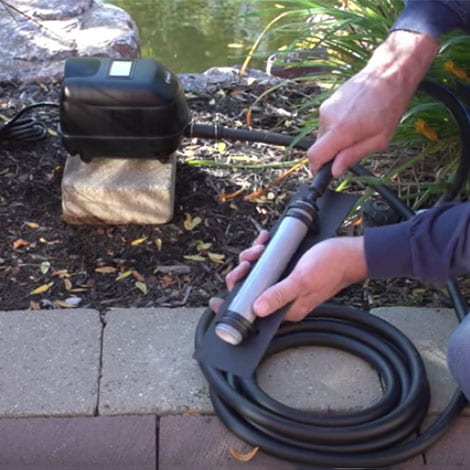A: Shutting down the waterfall for the winter makes a lot of sense for water garden hobbyists. Not only will it save on operating costs, but it will also prolong the life of your equipment, prevent ice dams from forming and potentially draining your pond, and save on a lot of hassle and worry.
You may be wondering
why aerate? With the waterfall off, the pond will need another source of oxygen – and that's where an aeration system comes into play. It pumps O2 into the water and maintains a gas exchange hole in the ice, ensuring any finned friends are safe and well through the cold season.
We've got some expert tips on aeration for you. Here's what we recommend for making the most of your system.
- Size It Right: Install an aeration system that's large enough to properly ventilate your pond volume. An "a little is better than nothing" approach might not be enough to keep your fish safe. If your pond is less than 4,000 gallons, consider The Pond Guy Pond Aerator. If it's between 4,000 and 16,000 gallons, try the KoiAir Aeration Kit.
- Pair with a De-icer: Though the water movement created by aeration can prevent most surface ice formation, add a de-icer just in case nighttime temperatures turn frigid. The PondAir & Pond De-Icer Combo – a combination kit containing an aerator and de-icer – is perfect for this. On particularly windy nights, you might see ice form even with a de-icer, but don't worry. The aeration system is still adding oxygen to the pond, and the combination of the two will eventually reopen the hole.
- Position in Shallows: Rather than place your diffusers in the deepest areas of your pond where your fish hang out in the winter, put them in the shallows or near the surface. Doing so will provide more water movement and better keep a hole in the ice.
- Watch the Ice: If ice does form, don't panic! Keep an eye on the ice. If a ventilation hole doesn't reopen on its own within a few days, pour a bucket of hot water on the ice to help melt it open. Don't – we repeat – don't pound on the ice to break it apart. Your fish won't like it. In fact, the sound waves will stress your fish, compromise their immune systems and could kill them.
- Maintain for Best Results: Mechanical pieces and parts need to be maintained, and so if you've been using your aeration system for the summer or it has been dormant since last winter, it'll need some attention. Check to make sure the air stones/diffusers are working properly, and install a maintenance kit to ensure it's working to its full potential.

